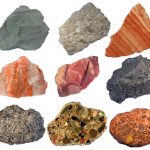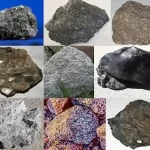The change of a caterpillar into a butterfly is called metamorphosis: meaning, to transform. A similar term- metamorphism – is used to describe the change of a rock into a new type of rock. Such change may be brought about by extreme heat or pressure. These are called metamorphic rocks.
Based on their appearance and texture, metamorphic rocks can be divided into two groups – foliated and nonfoliated. Foliated rocks are ones that are made up of layers, like the pages of a book.
One example of foliated rocks is slate, a water-proof rock. Slate, which begins as shale, is a very hard and smooth rock that is able to split into thin, leaflike layers. You may see slate-covered roofs on some older buildings.

Many metamorphic rocks do not have a layered appearance or texture. and are therefore called nonfoliated rocks.
Perhaps the most beautiful nonfoliated rock is marble, a rock that was once limestone, but was hardened by extreme heat and pressure within the earth. Marble is often use to make statues and monuments due to its ability to withstand weathering better than most rocks. The finest deposits of marble are found in Italy, where the great artist Michelangelo carved his statues of David and Moses from large pieces of marble. Marble today is greatly valued for making kitchen countertops and sinks.








